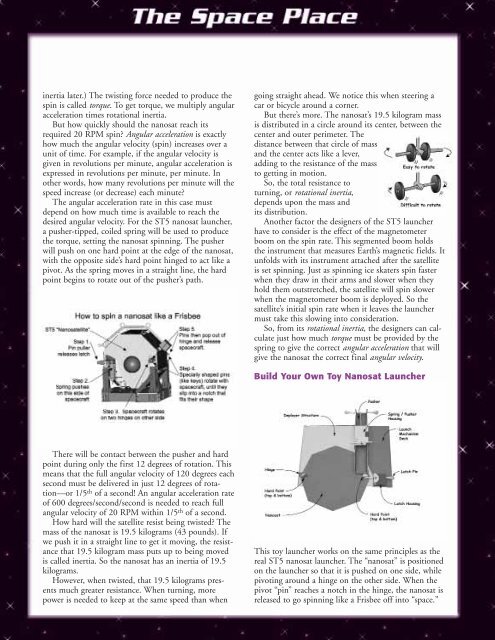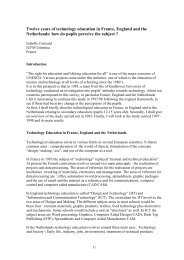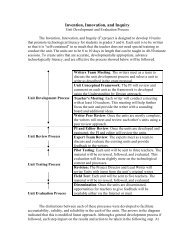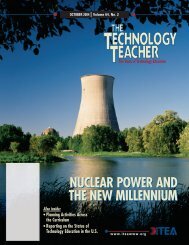april 2003 vol. 62 no. 7 - International Technology and Engineering ...
april 2003 vol. 62 no. 7 - International Technology and Engineering ...
april 2003 vol. 62 no. 7 - International Technology and Engineering ...
Create successful ePaper yourself
Turn your PDF publications into a flip-book with our unique Google optimized e-Paper software.
inertia later.) The twisting force needed to produce the<br />
spin is called torque. To get torque, we multiply angular<br />
acceleration times rotational inertia.<br />
But how quickly should the na<strong>no</strong>sat reach its<br />
required 20 RPM spin? Angular acceleration is exactly<br />
how much the angular velocity (spin) increases over a<br />
unit of time. For example, if the angular velocity is<br />
given in re<strong>vol</strong>utions per minute, angular acceleration is<br />
expressed in re<strong>vol</strong>utions per minute, per minute. In<br />
other words, how many re<strong>vol</strong>utions per minute will the<br />
speed increase (or decrease) each minute?<br />
The angular acceleration rate in this case must<br />
depend on how much time is available to reach the<br />
desired angular velocity. For the ST5 na<strong>no</strong>sat launcher,<br />
a pusher-tipped, coiled spring will be used to produce<br />
the torque, setting the na<strong>no</strong>sat spinning. The pusher<br />
will push on one hard point at the edge of the na<strong>no</strong>sat,<br />
with the opposite side’s hard point hinged to act like a<br />
pivot. As the spring moves in a straight line, the hard<br />
point begins to rotate out of the pusher’s path.<br />
going straight ahead. We <strong>no</strong>tice this when steering a<br />
car or bicycle around a corner.<br />
But there’s more. The na<strong>no</strong>sat’s 19.5 kilogram mass<br />
is distributed in a circle around its center, between the<br />
center <strong>and</strong> outer perimeter. The<br />
distance between that circle of mass<br />
<strong>and</strong> the center acts like a lever,<br />
adding to the resistance of the mass<br />
to getting in motion.<br />
So, the total resistance to<br />
turning, or rotational inertia,<br />
depends upon the mass <strong>and</strong><br />
its distribution.<br />
A<strong>no</strong>ther factor the designers of the ST5 launcher<br />
have to consider is the effect of the magnetometer<br />
boom on the spin rate. This segmented boom holds<br />
the instrument that measures Earth’s magnetic fields. It<br />
unfolds with its instrument attached after the satellite<br />
is set spinning. Just as spinning ice skaters spin faster<br />
when they draw in their arms <strong>and</strong> slower when they<br />
hold them outstretched, the satellite will spin slower<br />
when the magnetometer boom is deployed. So the<br />
satellite’s initial spin rate when it leaves the launcher<br />
must take this slowing into consideration.<br />
So, from its rotational inertia, the designers can calculate<br />
just how much torque must be provided by the<br />
spring to give the correct angular acceleration that will<br />
give the na<strong>no</strong>sat the correct final angular velocity.<br />
Build Your Own Toy Na<strong>no</strong>sat Launcher<br />
There will be contact between the pusher <strong>and</strong> hard<br />
point during only the first 12 degrees of rotation. This<br />
means that the full angular velocity of 120 degrees each<br />
second must be delivered in just 12 degrees of rotation—or<br />
1/5 th of a second! An angular acceleration rate<br />
of 600 degrees/second/second is needed to reach full<br />
angular velocity of 20 RPM within 1/5 th of a second.<br />
How hard will the satellite resist being twisted? The<br />
mass of the na<strong>no</strong>sat is 19.5 kilograms (43 pounds). If<br />
we push it in a straight line to get it moving, the resistance<br />
that 19.5 kilogram mass puts up to being moved<br />
is called inertia. So the na<strong>no</strong>sat has an inertia of 19.5<br />
kilograms.<br />
However, when twisted, that 19.5 kilograms presents<br />
much greater resistance. When turning, more<br />
power is needed to keep at the same speed than when<br />
This toy launcher works on the same principles as the<br />
real ST5 na<strong>no</strong>sat launcher. The “na<strong>no</strong>sat” is positioned<br />
on the launcher so that it is pushed on one side, while<br />
pivoting around a hinge on the other side. When the<br />
pivot “pin” reaches a <strong>no</strong>tch in the hinge, the na<strong>no</strong>sat is<br />
released to go spinning like a Frisbee off into “space.”
















